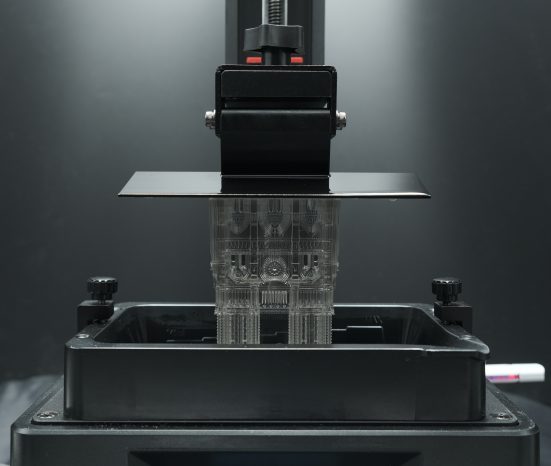3D Printing
What is 3D Printing?
3D printing, also known as additive manufacturing, is a process that constructs three-dimensional objects from digital models. Here is how it works:
- Digital Model Creation: First, a CAD (Computer-Aided Design) model or a digital 3D model is created. This model serves as the blueprint for the object to be printed.
- Layer-by-Layer Construction: The 3D printer builds the object by adding material layer by layer. Various materials can be used, including plastics, liquids, or powder grains. The printer follows the instructions from the digital model to deposit, join, or solidify the material under computer control.
- Complex Shapes and Geometries: One of the key advantages of 3D printing is its ability to produce complex shapes or geometries that would be challenging to create by hand. This includes hollow parts or components with internal truss structures which can reduce weight while minimizing material waste.
- Fused Deposition Modelling (FDM): FDM, which uses a continuous filament of thermoplastic material, is the most common 3D printing process in use today.
In the past 3D printing was mainly used for functional or aesthetic prototypes. However, advancements in precision, repeatability, and material range have made some 3D printing processes viable for industrial production. As a result, the terms “3D printing” and “additive manufacturing” are often used interchangeably. If you’re interested in exploring this technology further, there are various applications across industries, including manufacturing, automotive, and more.
3D printing involves a variety of materials, each with unique properties suited for different applications. The following are some common ones:
Thermoplastics
These are the most commonly used plastics in 3D printing. Thermoplastics can go through multiple melt and solidification cycles. They can be heated, formed into the desired shape, and then re-melted and reused. Examples include:
- ABS (Acrylonitrile Butadiene Styrene): Known for its strength, impact resistance, and versatility.
- PLA (Polylactic Acid): Biodegradable and easy to print. Often used for prototypes and hobbyist projects.
- PETG (Polyethylene Terephthalate Glycol): Combines strength with flexibility and transparency.
- Nylon: Offers durability, flexibility, and resistance to wear.
Thermosetting Plastics (Thermosets)
Unlike thermoplastics, thermosets remain in a permanent solid state after curing. They do not melt upon heating. Examples include:
- Epoxy Resin Used for high-strength, heat-resistant parts.
- Polyurethane Resin: Ideal for flexible and impact-resistant objects.
Metal Materials
Metal 3D printing is gaining popularity for industrial applications. Common metals include:
- Stainless Steel: Used for functional parts and prototypes.
- Titanium: Known for its lightweight and biocompatibility.
- Aluminium: Offers good strength-to-weight ratio.
Composites
These combine different materials to enhance specific properties. Examples include:
- Carbon Fiber Reinforced Polymers: Lightweight and strong.
- Glass Fiber Reinforced Polymers: Stiffness and heat resistance.
The choice of material depends on the project requirements, whether it’s for prototyping, functional parts, or artistic creations.
3D Printing in the Aerospace Industry
3D printing plays a crucial role in the aerospace industry, offering several benefits that enhance innovation, reduce costs, and improve production. Here are some ways 3D printing is used in aerospace manufacturing:
Prototyping and Concept Models
- Aerospace designers and engineers use 3D printing to create concept models and showcase components of aircraft designs. These models help communicate design intentions and are essential for aerodynamic testing.
- Technologies like Stereolithography (SLA) and Material Jetting produce high-detail, smooth-scale models for accurate representation.
Validation and Prototyping
- 3D printing is commonplace for prototyping in aerospace. It allows rapid production of various parts, from full-size landing gear enclosures to detailed control board concept models.
- Engineers can validate and test prototypes using 3D-printed parts made from engineering materials.
Pre-production and Rapid Tooling
- One of the most disruptive applications of 3D printing is in rapid tooling. Aerospace companies use 3D printing to create low-cost tooling for injection moulding, thermoforming, and jigs and fixtures.
- This approach mitigates risks associated with investing in high-cost tooling during production. Low-cost rapid tooling can be used for quantities from 5,000 to 10,000 parts.
Production of End-Use Parts
- While 3D printing has historically been used primarily for prototyping, it is increasingly being explored for manufacturing end-use parts.
- Aerospace manufacturers leverage 3D printing to create intricate geometries, lightweight components, and high-strength parts. This contributes to fuel efficiency and cost savings.
Complex Component Creation
- 3D printing enables the production of complex components that were previously impossible using traditional manufacturing techniques.
- Aerospace organizations like NASA, SpaceX, and Airbus utilize 3D printing technology to create innovative parts.
Weight Reduction and Fuel Efficiency
- In an industry where weight reduction directly impacts fuel efficiency and operational costs, 3D printing allows manufacturers to design lighter aircraft components.
- The ability to create intricate structures and optimize material usage contributes to overall weight reduction.
In summary, 3D printing accelerates innovation in aerospace by providing flexible design options, faster prototyping, and the potential for more efficient production of end-use parts. Its impact continues to grow as technology advances and materials improve.
Evolution of 3D Printing

The evolution of 3D printing, also known as additive manufacturing, began in the 1980s with the development of stereolithography (SLA) by Charles Hull. This process used ultraviolet lasers to solidify thin layers of photopolymer, creating detailed 3D objects. The technology progressed with the introduction of Selective Laser Sintering (SLS) and Fused Deposition Modeling (FDM) in the late 1980s and early 1990s, which broadened the range of materials that could be used, including plastics, metals, and ceramics. Throughout the 2000s, 3D printing technology became more accessible and affordable, leading to its adoption in various industries such as aerospace, healthcare, and automotive. Advances in materials science and software have further enhanced the precision, speed, and capabilities of 3D printers, allowing for complex geometries and customized manufacturing. Today, 3D printing is revolutionizing manufacturing processes, enabling rapid prototyping, on-demand production, and the creation of intricate structures previously impossible with traditional manufacturing techniques.
Aerospace & 3D Printing in Future
In the future, 3D printing will revolutionize the aerospace industry by enabling the production of lighter, more efficient components with complex geometries that traditional manufacturing cannot achieve. This technology will allow for rapid prototyping and customization, significantly reducing the time and cost of developing new aircraft and spacecraft. Moreover, 3D printing will facilitate on-demand production of spare parts, enhancing maintenance processes and reducing downtime. As materials and techniques continue to advance, 3D printing will contribute to the creation of more sustainable and high-performance aerospace vehicles, ultimately transforming the industry’s approach to design and manufacturing.

Frequently Asked Questions
Common questions and answers pertaining to 3D printing, especially in regards to aviation.
How is 3D printing used in the aviation industry?
3D printing is used in aviation to create complex, lightweight components, streamline prototyping processes, and produce on-demand spare parts. This technology allows for innovative designs that enhance performance and reduce the weight of aircraft, leading to improved fuel efficiency and lower emissions.
What are the benefits of using 3D printed parts in aircraft?
The benefits of using 3D printed parts in aircraft include reduced weight, which enhances fuel efficiency, shortened development and production cycles, cost savings from minimized material waste, and the ability to produce intricate designs that are difficult or impossible to achieve with traditional manufacturing methods.
Are 3D printed components reliable and safe for use in aircraft?
Yes, 3D printed components for aviation are subject to rigorous testing and certification processes to ensure they meet stringent safety and reliability standards. These parts are evaluated for their mechanical properties, durability, and performance under various conditions to ensure they are safe for use in critical aerospace applications.
What types of materials are used for 3D printing in aviation?
In aviation, 3D printing utilizes a range of materials including high-strength metals such as titanium and aluminum, advanced polymers, and composite materials. These materials are chosen for their strength, lightweight properties, and ability to withstand extreme temperatures and stresses encountered during flight.
How does 3D printing impact the supply chain in the aviation industry?
3D printing significantly impacts the aviation supply chain by enabling decentralized manufacturing and reducing dependency on traditional supply chains. This technology allows for on-demand production of parts, reducing inventory requirements and lead times. It also facilitates rapid prototyping and iterative design changes, improving overall efficiency and responsiveness in the production process.
Video Explanation
The video below will provide more information as to how this technology works
Example Industry User

GKN Aerospace integrates 3D printing technology to enhance its manufacturing processes and produce complex aerospace components with greater efficiency and precision. By utilizing additive manufacturing, GKN Aerospace can create lighter, stronger parts that reduce material waste and production costs. This technology enables rapid prototyping and more flexible design iterations, accelerating innovation and improving performance in aerospace applications.
Further Resources
Below are some external links which explain more about 3D printing




